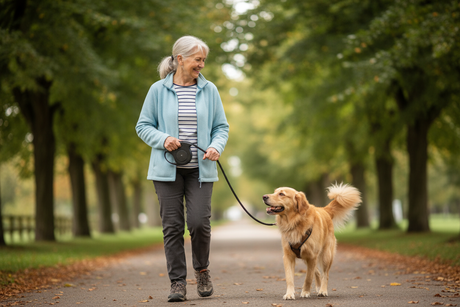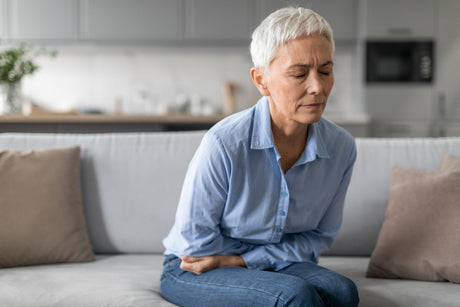As we age, there often comes a point where managing a home on our own becomes difficult. Although it is common for people to move to a care facility where they can get help with daily needs, more and more often people are choosing to stay in their homes.
It’s no surprise why this option is appealing. Aging in place allows you to stay in a familiar place, in the home space you’ve created for yourself and where you feel most comfortable. If aging in place sounds like a good idea to you, you’re not alone. According to AgingInPlace.org, 77% of adults 50 and older want to remain in their homes for the long term. That’s why, over the past several years, the idea of “aging in place” has grown in popularity.
To help us explore this topic, we chatted with Liz Sudberry, Director of Client Experience at TheKey of Ohio, the largest premium provider of in-home care in North America. Sudberry and her team are passionate about helping older adults live well in their own homes as they age.
What is Aging in Place?
Aging in place is simply the idea of staying in your current home, or the home of your choosing, as you get older. Rather than moving into a senior living community, assisted living facility, or nursing home, many older adults opt to age in a place that’s familiar and live more on their own terms. The U.S. Centers for Disease Control and Prevention defines aging in place as: “the ability to live in one's own home and community safely, independently, and comfortably, regardless of age, income, or ability level.” But that doesn’t necessarily mean living alone or just with a partner who’s also aging. Part of aging in place, for many, means bringing in help to ensure they receive the support and care they need—whether that’s a person to help with cleaning, running errands, home maintenance, or healthcare needs. Because another part of aging in place is being prepared for the changes that occur in your life as you age.
Is Aging in Place Right for You?
Is aging in place the best decision for you or your loved one? It all depends on your situation. Sudberry says one of the major factors in making this decision is finances and how well people have prepared. Unfortunately, not everyone can afford to age in place. “Very few [older adults] can afford to age in place with their own resources that they have accumulated,” she says.

If you aren’t able to live at home with your own funds, there are social services available to help our nation’s aging population stay at home. Medicare and VA benefits may potentially help, along with government assistance programs that provide assistance to lower-income individuals. Sudberry also says, “A third of our clients have long-term care insurance and that is what enables them to receive [TheKey’s] private care.” So, there are ways to make it work. One other way to make aging in place more affordable? Living with a child and sharing a home with their family.
Beyond looking at your finances, take the time to assess your health, personal needs, and the space in which you or your loved one currently lives. You also need to ensure you have access to the additional care and support you need when aging in place. All of these factors will help determine if aging in place is the best option for your situation.
The Benefits of Aging in Place
There are many reasons to age in place. First, aging in place can boost your self-esteem, as you’re able to maintain your daily habits and stay in your own home and neighborhood. It can also be cheaper for people who need minimal to moderate assistance–if you only need daytime care, you might be better off hiring occasional help rather than paying for a full-time living facility. Finally, aging in place is good for staying healthy, both mentally and physically, as you’re able to maintain your routines and avoid some of the potential infectious disease concerns that come with living in a senior living facility.
The Challenges of Aging in Place
Let’s start with the obvious: aging in place can be lonely. Older adults are often socially isolated, leading to feelings of loneliness and depression. Social isolation can increase your risk of dementia, stroke, and negative outcomes from heart attacks or falls. If you choose to age in place, consider how to maintain your social connections or make more connections in order to prevent loneliness.
Aging in place can also be expensive under certain circumstances. If your home requires extensive maintenance, you don’t own your home, or if you need higher levels of care, you might find aging in place costs more than you can reasonably afford. A full-time caregiver might be as expensive or more expensive than a group living facility, and can also be difficult to find.
You can absolutely overcome these challenges, but it will take some work, and a willingness to find creative solutions.
How to Age in Place Successfully
Coping with Declining Mobility
Declining mobility is a huge concern for people as they age. The risk of falling greatly increases as you age—in fact, Sudberry notes that falls are the number one cause of death for older adults. If you’re living in a private residence, make sure you’re set up for success as much as possible. For some, that simply means rearranging and/or decluttering a home to make walkways more wide and clear. This is important for any older adult, but it’s of particular importance for those who use mobility aids like canes, wheelchairs, walkers, or rollators.
Sometimes, making space means widening doorways or adding in ramps to accommodate wheelchairs. Can you afford these changes? Can they be done to your current home? Consider moving in with a family member or finding a more accessible home that you can age into more easily.
Other mobility issues to consider are bathrooms. For those dealing with incontinence, it’s particularly important to ensure that the path from the main rooms in the home to the bathroom is clear. As your mobility declines, consider setting up a bedside commode to prevent potential accidents or falls on the way to the bathroom.
Handling Safety Concerns in the Home
You might be concerned about accidents in the home. In connection with getting around and ease of movement within a home, it’s important to consider if modifications can be made to a home to help the physical space be more aging-friendly. “Home modifications are super important,” Sudberry says. “But you want to do a little bit of shopping around when it comes to home modifications because you don't want to overdo it and you don't want to underdo it.” Modifying your home could be as simple as adding grab bars to the bathroom or a ramp going up to the front door. With a few modifications, your home can become a much more comfortable space to live. Sudberry suggests going to homemods.org or help4seniors.org for home modification resources.
In addition, consider whether you feel safe in your current neighborhood. If you have the ability to connect with your neighbors and build up your local support network, now is a great time to start. If you think you’d feel safer living close to friends or family, consider how you might be able to do that. Other safety concerns might be addressed by installing a security system and wearing a device that can automatically detect falls and contact emergency services. To feel safe and prepared, it’s important to acknowledge potential safety concerns and address how one might deal with those situations if they arise.
Toileting and Hygiene
The bathroom can be a big source of anxiety for aging adults—even those who feel otherwise fairly independent. The risk of falls often increases when bathing or using the toilet, and if dealing with incontinence is part of the equation, cleaning up after an accident can feel daunting.

Bath safety products like grab bars, bath benches, and raised toilet seats can help you feel safer using the bathroom on your own. For hygiene concerns, first make sure to talk openly and honestly about your needs and concerns with anyone who is going to be helping with your personal care. They may need to get some training on how to best help you.
Maintaining good hygiene also means preparing with good bladder protection products, using barrier creams to protect your skin against irritation, and learning more about incontinence skin care so you can stay clean and comfortable after accidents.
Get Help When You Need It
As you age, you may not have the same energy as you had before. Take care of yourself and give yourself some breathing room by hiring in-home help and asking for assistance for friends and family.

Home health aides and nurses can offer medical assistance, and you can also hire handymen, cleaning services, or personal chefs. (For those who still feel comfortable using the kitchen, meal kits are another great way to get simple, nutritious meals delivered right to your door which are pre-portioned and ready to prepare.) For some people, you might have a family member who can help as a daytime or live-in caregiver, or you might use adult daycare services when needed.
How to Plan for Aging in Place
Start Early with a Financial Plan
Just like planning for retirement, it’s never too early to begin planning for aging in place. Consider your monthly income and expenses, budget for big purchases, health care, and who to give authority to handle your finances if you’re unable to. For more financial planning resources, look for your local Area Agency on Aging or contact a certified financial planner who can help you plan for and achieve your financial goals.
Choose Your Location
Aging in place doesn’t necessarily mean aging in your current residence. If your current home requires lots of maintenance, consider downsizing. If your friends and family live elsewhere, consider moving closer. If you live in a climate you don’t love or that’s not good for your health, consider moving to find better weather. Finding housing that works for you is one of the most important factors in maintaining a good quality of life as you get older.
Wherever you choose to move, make sure you can access the healthcare and social services you need near your home.
Stay Close to Your Support System
One key support for older adults is social connection. If you have social connections in your life already, great! Keep making the effort to maintain those connections as you age to improve your health and wellbeing and the health of your friends. If you feel isolated, work now on building up your group of friends and acquaintances. If you are having a hard time, talk to a therapist about how to make friends and build up your confidence.
Another key support is personal care and health care. If you are aging in place, make sure you can access the health care you need, whether that is a doctor who knows you well, a hospital, or specialists who can help with your specific needs. Also make sure you live near where you can get personal help. This could be friends or family, or volunteer and professional caregivers.
Finally, if your family is your key support network, consider moving to be closer to them.
Maintain Your Routines
Maintaining routines is important for maintaining social connections, a sense of purpose, and for avoiding depression as you get older. When we stop doing the activities we used to love, we start to become more and more depressed, which can lead to even more withdrawal and social isolation. Even if it seems like a lot of work sometimes, keeping up with the activities and routines you’ve made over the years can help you to stay healthy and have a positive outlook as you get older.
Prioritize Your Health
Focusing on your health comprises a range of behaviors, from good hygiene to healthy eating and exercise. If you struggle to maintain a healthy diet or if food is becoming less interesting to you, try a healthy meal supplement like a nutritional shake to get the vitamins and minerals you need without the hassle.
For some ideas to help you maintain fitness as you get older, check our articles on posture exercises, hip stretches, and the benefits of dancing for older adults. And because fitness is always easier when you’re doing it with friends, look for exercise classes geared toward seniors at your local gyms or community centers to get the double benefit of social time and fitness time
Aging in Place Resources for Seniors and Caregivers
The best resource for securing your financial future and making sure you can afford to age in place is a certified financial planner. Also check with your veterans agency and with Medicaid to find benefits available for seniors that you may have missed.
Organizations designed to help older adults access senior benefits and discounts, like the AARP, can also be a valuable resource for you, especially if you’re planning to travel or start a business in your retirement years.
Finally, look to caregiving organizations like TheKey and similar organizations near you to find assistance for your daily needs.
If you’re a caregiver, start here for resources to help you find support. It’s important for you to have compassion for yourself as well as the person you’re caring for.
Aging in place is a great option that should be available to everyone; however, not everyone will want to age in place. If this approach isn’t right for you, you can also explore Continuing Care Retirement Communities (CCRCs), which provide assistance and support for your daily life while allowing you to maintain your independence for as long as possible.














